Pat Mora's Blog, page 75
August 26, 2011
New Translation
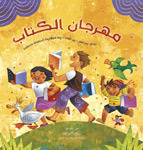 An Arabic edition of
Book Fiesta!
Celebrate Children's Day/ Book Day • Celebremos El día de los niños/ El día de los libros is now available. It's published by Kalimat Publishing and Distribution and the ISBN is 978-9948-16-075-5.
An Arabic edition of
Book Fiesta!
Celebrate Children's Day/ Book Day • Celebremos El día de los niños/ El día de los libros is now available. It's published by Kalimat Publishing and Distribution and the ISBN is 978-9948-16-075-5. Did you know that several of Pat's titles are available in languages other than Spanish? Try these:
The Night the Moon Fell -- also available in Korean, ISBN 89-7057-645-2
Race of Toad and Deer -- also available in Korean, ISBN 89-517-2093-4
Song of Francis and the Animals -- also available in Korean from Nexus Junior
Tomás and the Library Lady -- also available in Japanese
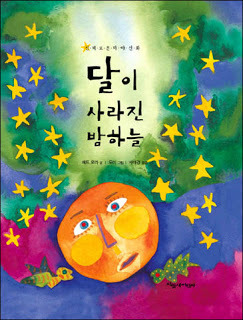
Published on August 26, 2011 08:11
August 18, 2011
Creativity Interview: Guadalupe Garcia McCall
 I'll begin by saying: Who has her first book coming out this fall? My guest Guadalupe Garcia McCall. Her verse novel,
Under the Mesquite
, will be published in September. I met Guadalupe through e-mail, and we soon discovered our many connections including a love of nature. Congratulations on your verse novel, Guadalupe and welcome to Bookjoy Creativity Salon!
I'll begin by saying: Who has her first book coming out this fall? My guest Guadalupe Garcia McCall. Her verse novel,
Under the Mesquite
, will be published in September. I met Guadalupe through e-mail, and we soon discovered our many connections including a love of nature. Congratulations on your verse novel, Guadalupe and welcome to Bookjoy Creativity Salon!1. So how does it feel to have your first book published?
GGM: This is an amazing feeling, indescribable. When the ARCs first came in, I walked around the house holding it like a baby, carrying it everywhere. I would stand it on the counter and look at it while I cooked. I stood it next to me on my desk and watched it while I worked on novel number 2. I think I read it in ARC form like 20 times because it was such a dream come true.
2. Tell us about your publishing journey.
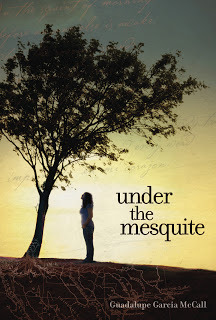
Under the Mesquite (Sept. 2011)
GGM: It has really been quite a journey. Under the Mesquite started as a collection of poems I wrote over many years when I wanted to "show" my students how easy writing poetry can be. They would say, "This is hard," and I would show them how easy it was by just taking a memory and turning it into a poem in class. Of course, I had to rewrite it for every class, so by the end of the day, the poem was usually revised several times. I started collecting these "little poems" and when I had about 35 of them, I sent them out. Emily Hazel, my editor at Lee & Low, saw the potential for a novel in verse in them, and the rest is history.
3 . Did you always want to be a writer?
GGM: Oh, yes, always. My first memories of writing are special. My father taught me to write so that I would be "prepared" for school in the United States. I loved listening to the pencil "whisper the words" as it travelled on the paper with his hand guiding mine. But the one who really put the idea in my head was my third grade teacher, Mr. Hernandez. After he read one of my stories (I was in a bilingual classroom, so I wrote it in Spanish) he asked me if I had written the story by myself. I said I had, and he said, "Someday, you're going to be a writer." Of course, hearing him say it cemented it in my head. It's amazing the profound effect a good teacher can have on us. If Mr. Hernandez hadn't said it quite like that, I might not have grown up believing it.
4. Have you always thought of yourself as creative? How do you nurture your creative life?
GGM: I have always loved the arts. My father, who was a carpenter, was very creative. He used to play the guitar, sing, and draw. One day, I came home from school crying because my teacher had given me a zero on a drawing of the earth. He sat down and taught me how "easy" drawing could be. It opened up the world of art for me.
My mother too was instrumental in helping me find my creativity. She recognized that I was "artistic" before I did and enrolled me in singing, dancing, and acting classes in Mexico when I was in elementary. I love to sing (although, I am not good at it) and still draw. I nurture my creative side by staying close to nature. I find nature is the most artistic entity of all. The movement of the elements as they interact is dance, the sounds of water and fire and air is music, and everything that happens on our planet is performance, and it's all out there, a feast for the senses, if we just open our eyes and feel and look with our hearts.
5. You are an experienced and committed teacher. What are your key challenges as a teacher? As a writer?
GGM: As a teacher and as a writer and as a mother and also as a person, I find that my biggest challenge in life is patience. I am not as patient as I'd like to be with myself or others. I like to finish things fast. I love movement and productivity. It comes from having two very hard working parents and also being somewhat of a perfectionist. So, every day I pray for patience and force myself to wait for perfection to come at its own pace and dressed in its own favorite outfit, not mine.
6. Are you working on other writing projects?
GGM: Oh yes. Absolutely. I am always writing. I finished revising Six Little Sisters last month. It is a multicultural novel (prose) with lots of magic realism, and I hope to find it a home someday soon. And now I am finishing up another novel-in-verse tentatively titled I Am Joaquin. It is a multicultural YA historical piece based on the conflicts in South Texas resulting from the Plan de San Diego in 1915. I have to say I am really taken by the voice of Joaquin and the story he has to tell. I Am Joaquin deals with rebellion and social injustice, but, at the heart of it, is a story about a boy, his family, and the girl he loves.
7. What do you do to relax?
GGM: Believe it or not, I write to relax. To sit in front of the computer means that I have time away from everything else that is ordinary and average. To sit in front of the computer means that I am on "vacation" from my life. I love to sit and daydream and think profoundly about life. Don't get me wrong, I am a social person. I have many friends and I love to talk, but to be able to sit and think, that is special. That's having time for myself. Time to do what I want.
More information:
Read an interview with Guadalupe at BookTalk on the Lee & Low website.
Visit Guadalupe's website.
Published on August 18, 2011 06:47
July 28, 2011
Creativity Interview: Margarita Engle
I've had the pleasure of visiting with Margarita Engle, reading her books and savoring the Colorín Colorado interview below. I strongly recommend that you watch the interview for many reasons including to hear Margarita's eloquent response to why she writes in free verse.
Margarita, welcome to this Bookjoy Creativity Salon .
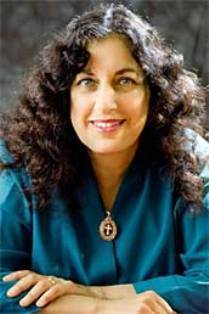 Photo by Marshall W. Johnson Hello, my name is Margarita Engle, and I write young adult novels in free verse, primarily about Cuban history. Although I was born in Los Angeles, my mother is from Cuba. When I was a child, we spent summers on the island, and I developed the deep attachment that inspires my writing.
Photo by Marshall W. Johnson Hello, my name is Margarita Engle, and I write young adult novels in free verse, primarily about Cuban history. Although I was born in Los Angeles, my mother is from Cuba. When I was a child, we spent summers on the island, and I developed the deep attachment that inspires my writing.
1. You've said you were a book worm as a child and connected that to then becoming a writer. Many readers, though they may love reading, do not become writers. How/why, then, do you think your writing life began?
ME: I loved The Black Stallion, and Island of the Blue Dolphins. Both were books about children stranded on islands, trying to survive. Looking back, I think I must have related to those stories because of the Missile Crisis, travel restrictions, and my own sense of isolation from Cuba. Growing up in the hectic city of Los Angeles, I craved the peace of nature. Writing was an exploration, and an escape. I started writing lyrical nature poems when I was very young. The only one I vaguely remember was about dry hills that looked like brown lizards. I do remember that writing felt comforting, and it still does.
2. Your books have appropriately received many awards. You are the first Latina (o) to receive a Newbery Honor Award, yes? What is your reaction to that fact?
ME: I walked through the Newbery ceremony in a daze. To this day, I still suspect that I might have been dreaming. I didn't realize how much it meant to the Latino community, until I was included in articles and books about women who changed America. It's humbling too, because all I did was daydream on paper. I feel like I'm standing on the shoulders of Latino earlier Latino authors who were not honored.
3. What is your personal writing challenge?
ME: There are so many tempting stories, and so many fascinating subplots. It's easy to get sidetracked. Each time I start a book, I have to write a note to myself about the theme. Later, when I feel confused, I can read the note and remember what I'm really trying to say. When I finish the book, the note becomes my "Author's Note."
4. Have you always thought of yourself as creative? How do you nurture your creative life?
ME: I have always been a daydreamer. My mother must have mistaken my daydreams for philosophy, because when I gazed into space, she would tell people not to bother me while I was thinking! She understood the key to creativity: quiet time. In the modern world, that means turning off noisy gadgets and electronic interruptions. I need time alone in a hammock, or out in the woods, walking... Many great poets (Antonio Machado!) have been avid walkers. The rhythm of footsteps turns into the music of verse.
5. Would you like to tell us about the projects you're working on or topics that intrigue you, those, to use your words, that now "haunt" you?
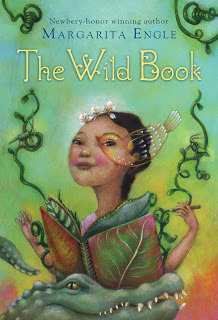 ME: My next novel in verse is The Wild Book, scheduled by Harcourt for March, 2012. Unlike my historical books, this one is completely personal. It was inspired by stories my grandmother told me about her childhood. She grew up on a farm during the chaos following the U.S. occupation of Cuba after the "Spanish-American" War. She also had dyslexia, so the book is dedicated to reluctant readers. Exploring my grandmother's childhood, and taking on her voice, was an emotional experience!
ME: My next novel in verse is The Wild Book, scheduled by Harcourt for March, 2012. Unlike my historical books, this one is completely personal. It was inspired by stories my grandmother told me about her childhood. She grew up on a farm during the chaos following the U.S. occupation of Cuba after the "Spanish-American" War. She also had dyslexia, so the book is dedicated to reluctant readers. Exploring my grandmother's childhood, and taking on her voice, was an emotional experience!
My next picture book is about search and rescue dogs, it's scheduled by Holt/Macmillan for 2013. This topic comes from my husband's volunteer work, training our two dogs in the Sierra Nevada Mountains. I am a volunteer "victim." I hide in the forest, so the dogs can practice finding a lost hiker.
6. You've talked about writing about people who made "hopeful choices." In what ways is writing a "hopeful" choice for you?
ME: I won't write a story for young people unless it has a hopeful ending, so every time I start exploring some complex historical situation, I'm forced to choose the optimistic aspects. I can only go ahead with the project if I discover that there were people who were kind while surrounded by cruelty, or fair while surrounded by injustice. If I don't find documented examples of admirable qualities, I drop that project, and move on to something else.
7. To end on a lighter note, what makes Margarita really laugh?
ME: Animals and folklore! In my daily life, our dogs make me laugh. They help me remember how to be silly. In my literary life, the exaggeration found in Cuban folktales is hilarious. I am trying to include some of that folklore in my writing.
Visit Margarita Engle's website.


Margarita, welcome to this Bookjoy Creativity Salon .
 Photo by Marshall W. Johnson Hello, my name is Margarita Engle, and I write young adult novels in free verse, primarily about Cuban history. Although I was born in Los Angeles, my mother is from Cuba. When I was a child, we spent summers on the island, and I developed the deep attachment that inspires my writing.
Photo by Marshall W. Johnson Hello, my name is Margarita Engle, and I write young adult novels in free verse, primarily about Cuban history. Although I was born in Los Angeles, my mother is from Cuba. When I was a child, we spent summers on the island, and I developed the deep attachment that inspires my writing.1. You've said you were a book worm as a child and connected that to then becoming a writer. Many readers, though they may love reading, do not become writers. How/why, then, do you think your writing life began?
ME: I loved The Black Stallion, and Island of the Blue Dolphins. Both were books about children stranded on islands, trying to survive. Looking back, I think I must have related to those stories because of the Missile Crisis, travel restrictions, and my own sense of isolation from Cuba. Growing up in the hectic city of Los Angeles, I craved the peace of nature. Writing was an exploration, and an escape. I started writing lyrical nature poems when I was very young. The only one I vaguely remember was about dry hills that looked like brown lizards. I do remember that writing felt comforting, and it still does.
2. Your books have appropriately received many awards. You are the first Latina (o) to receive a Newbery Honor Award, yes? What is your reaction to that fact?
ME: I walked through the Newbery ceremony in a daze. To this day, I still suspect that I might have been dreaming. I didn't realize how much it meant to the Latino community, until I was included in articles and books about women who changed America. It's humbling too, because all I did was daydream on paper. I feel like I'm standing on the shoulders of Latino earlier Latino authors who were not honored.
3. What is your personal writing challenge?
ME: There are so many tempting stories, and so many fascinating subplots. It's easy to get sidetracked. Each time I start a book, I have to write a note to myself about the theme. Later, when I feel confused, I can read the note and remember what I'm really trying to say. When I finish the book, the note becomes my "Author's Note."
4. Have you always thought of yourself as creative? How do you nurture your creative life?
ME: I have always been a daydreamer. My mother must have mistaken my daydreams for philosophy, because when I gazed into space, she would tell people not to bother me while I was thinking! She understood the key to creativity: quiet time. In the modern world, that means turning off noisy gadgets and electronic interruptions. I need time alone in a hammock, or out in the woods, walking... Many great poets (Antonio Machado!) have been avid walkers. The rhythm of footsteps turns into the music of verse.
5. Would you like to tell us about the projects you're working on or topics that intrigue you, those, to use your words, that now "haunt" you?
 ME: My next novel in verse is The Wild Book, scheduled by Harcourt for March, 2012. Unlike my historical books, this one is completely personal. It was inspired by stories my grandmother told me about her childhood. She grew up on a farm during the chaos following the U.S. occupation of Cuba after the "Spanish-American" War. She also had dyslexia, so the book is dedicated to reluctant readers. Exploring my grandmother's childhood, and taking on her voice, was an emotional experience!
ME: My next novel in verse is The Wild Book, scheduled by Harcourt for March, 2012. Unlike my historical books, this one is completely personal. It was inspired by stories my grandmother told me about her childhood. She grew up on a farm during the chaos following the U.S. occupation of Cuba after the "Spanish-American" War. She also had dyslexia, so the book is dedicated to reluctant readers. Exploring my grandmother's childhood, and taking on her voice, was an emotional experience! My next picture book is about search and rescue dogs, it's scheduled by Holt/Macmillan for 2013. This topic comes from my husband's volunteer work, training our two dogs in the Sierra Nevada Mountains. I am a volunteer "victim." I hide in the forest, so the dogs can practice finding a lost hiker.
6. You've talked about writing about people who made "hopeful choices." In what ways is writing a "hopeful" choice for you?
ME: I won't write a story for young people unless it has a hopeful ending, so every time I start exploring some complex historical situation, I'm forced to choose the optimistic aspects. I can only go ahead with the project if I discover that there were people who were kind while surrounded by cruelty, or fair while surrounded by injustice. If I don't find documented examples of admirable qualities, I drop that project, and move on to something else.
7. To end on a lighter note, what makes Margarita really laugh?
ME: Animals and folklore! In my daily life, our dogs make me laugh. They help me remember how to be silly. In my literary life, the exaggeration found in Cuban folktales is hilarious. I am trying to include some of that folklore in my writing.
Visit Margarita Engle's website.

Published on July 28, 2011 07:07
July 21, 2011
Día's 15th Anniversary Celebration at ALA
How I wish that the many Día supporters across the country could have been with us for the Día celebration session at ALA's annual conference in New Orleans last month. Below you'll see the delicious cake. My thanks to ALSC, and particularly Linda Mays, for arranging for the cake and music. The group cutting the cake -- Lucia Gonzalez, Jeanette Larson, Pat Mora, Cynthia Richey, and Oralia Garza de Cortes -- were all part of the panel. It was such a pleasure to hear each contribute so eloquently to describing Día's journey.
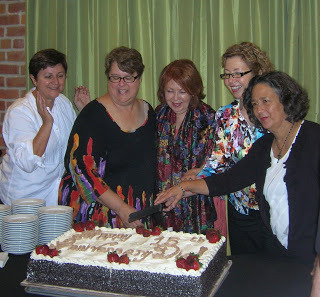 L to R: Lucia Gonzalez, Jeanette Larson, Pat Mora,
L to R: Lucia Gonzalez, Jeanette Larson, Pat Mora,
Cynthia Richey, Oralia Garza de Cortes
[image error] Celebrations can allow us to reflect on past successes and to unite in our vision for the future. I spoke of the sunflower, indigenous to Mexico and filling the air with its yellow exuberance, as a good symbol for Día. I hope you'll print this booklet that includes my vision for Día's future, many Nuggets or hints for planning your Día year, and 30 reflections on Día's important work.
I wish our literacy challenges received the kind of attention that sports events and celebrities receive. They don't. Our children are this nation's future, though, and thousands of children need literacy advocates to creatively link all children to books, languages and cultures. Join us!
[image error]
[image error]
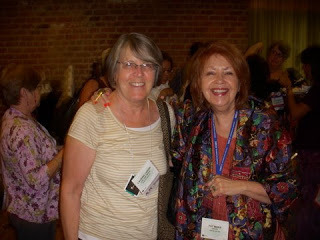 Pat and her friend and web manager Laurina Cashin at
Pat and her friend and web manager Laurina Cashin at
Dia's 15th Anniversary Celebration, ALA New Orleans, 2011.

 L to R: Lucia Gonzalez, Jeanette Larson, Pat Mora,
L to R: Lucia Gonzalez, Jeanette Larson, Pat Mora,Cynthia Richey, Oralia Garza de Cortes
[image error] Celebrations can allow us to reflect on past successes and to unite in our vision for the future. I spoke of the sunflower, indigenous to Mexico and filling the air with its yellow exuberance, as a good symbol for Día. I hope you'll print this booklet that includes my vision for Día's future, many Nuggets or hints for planning your Día year, and 30 reflections on Día's important work.
I wish our literacy challenges received the kind of attention that sports events and celebrities receive. They don't. Our children are this nation's future, though, and thousands of children need literacy advocates to creatively link all children to books, languages and cultures. Join us!
[image error]
[image error]
 Pat and her friend and web manager Laurina Cashin at
Pat and her friend and web manager Laurina Cashin at Dia's 15th Anniversary Celebration, ALA New Orleans, 2011.
Published on July 21, 2011 06:43
July 14, 2011
First Graders Talk about Pat's Books
[image error]
I'm so grateful to Martha Rico, librarian at Hawkins School in my home city of El Paso, Texas. Martha was kind enough to send me the video of her first grade students responding to my books by sending me their messages in Spanish. Isn't that creative and generous of Martha? I asked her the following questions.
1. How long have you been a librarian? MR: I have been a librarian 10 years.
2. What do you enjoy about the work?
MR: I enjoy being in the library because I work with the whole student body! I enjoy watching the students grow from kindergarten to fifth grade: to watch their likes and dislikes change as well as their personalities. It is especially momentous when a former student who is now in high school or older comes by and says, "I remember when you used to ....". That lets me know I have made a small impact on their lives. I also get to work with the entire faculty on various projects.
3. How do you select the books?
MR: Books are selected through reviews, student/teacher interest and award-winning books.
4. Do you think of yourself as creative?
MR: I wouldn't say I am creative at all. Sometimes I have a really good idea for a project or bulletin board or even for a lesson, but overall I don't consider myself creative.
5. Do you celebrate Día at your library? If not, will you next year? If yes, how do you plan and what happens?
MR: Honestly, I promote Día because our city hosts a big fair, but in the library I haven't done all that much. We usually get an email with all the info about it with a printable flyer that I post outside the library. It usually falls so close to state testing that it gets put on the back burner at my library. I will try to be a better advocate next year.
[image error] Hawkins Elementary School
1. How long have you been a librarian? MR: I have been a librarian 10 years.
2. What do you enjoy about the work?
MR: I enjoy being in the library because I work with the whole student body! I enjoy watching the students grow from kindergarten to fifth grade: to watch their likes and dislikes change as well as their personalities. It is especially momentous when a former student who is now in high school or older comes by and says, "I remember when you used to ....". That lets me know I have made a small impact on their lives. I also get to work with the entire faculty on various projects.
3. How do you select the books?
MR: Books are selected through reviews, student/teacher interest and award-winning books.
4. Do you think of yourself as creative?
MR: I wouldn't say I am creative at all. Sometimes I have a really good idea for a project or bulletin board or even for a lesson, but overall I don't consider myself creative.
5. Do you celebrate Día at your library? If not, will you next year? If yes, how do you plan and what happens?
MR: Honestly, I promote Día because our city hosts a big fair, but in the library I haven't done all that much. We usually get an email with all the info about it with a printable flyer that I post outside the library. It usually falls so close to state testing that it gets put on the back burner at my library. I will try to be a better advocate next year.
[image error] Hawkins Elementary School
Published on July 14, 2011 09:19
June 23, 2011
Creativity Interview: Maria Melendez
I have so enjoyed preparing for this interview with my friend, the poet and editor Maria Melendez, who presently lives with her family in Pueblo, CO. Welcome to this Bookjoy Creativity Salon, Maria.
[image error] Thank you, Pat! I'm honored to be part of the lively work you foster here. BTW, I loved seeing the photos of the mural for The Desert Is My Mother that you included in your last post. I'm thrilled when the arts can be wellsprings for each other.
I've just finished re-reading your two poetry collections. Bravo! Such variety you offer readers.
PM: When did your deep attention and connection to nature begin?
MM: Thanks to some good urban and suburban planning, and to my parents' motivation for picnics or hikes outdoors, I experienced wonder in wild nature throughout my childhood in the East Bay area of Northern California. Sunol Regional Wilderness, Del Valle Reservoir and Sycamore Grove Park inhabit me "deep in the brain, far back" (as Roethke says).
PM: Why poetry? I have a friend who teases me that he wonders why I don't just write in sentences and paragraphs, why don't I just write prose?
MM: That is such a loaded question for me; I feel I have to answer it every time I sit down to create new work. There are so many anti-poetry forces swirling around us/me, that I'm always having to talk myself into poetry. Well. I undergo something, in the process of working on poetry, that I don't undergo at any other time—a suite of sensations. I tried to write about this in an early poem called "Poeta Falsa," which appeared in the Swan Scythe Press chapbook Base Pairs. It ends with this answer to the persistent "Why poetry?" question: "because at no other time / am I as half-assed and ragged / as the early draft, / or as mammoth, as orchestral, / as the near-end." Ooh, I really get the willies when poets quote themselves, and here I've gone and done it.
PM: I was struck by the boldness of your work from incorporating scientific terminology to juxtaposing Our Lady with web lingo. In "Catamite," you write, "Where do you get the strength to be you?" Where do you get the strength to be the poet you are?
MM: When the writing process is hot and cookin', I'm surrendering to the interests and concerns I've been given. More than in everyday life and conversation, in poetry I'm free to link them together, as they always are in my emotional life. I've been really enjoying the idea of writing as surrender, rather than as an exertion of strength or will.
PM: You are the editor of Pilgrimage: Story • Spirit • Witness • Place. How long have you been the editor and what intrigued you about doing this work? In my experience, editors don't edit my poetry. They may make suggestions on my prose and copyeditors made plenty of suggestions on the definitions of poetic forms in Dizzy in Your Eyes, for example. How do you see your role as an editor?
MM: My family and I became Quakers, and that's occasioned my renewed attention to "spirit/Spirit" in contemporary writing. The areas of emphasis outgoing editor Peter Anderson brought to Pilgrimage (story, spirit, witness, place) appealed to me as a Chicana writer interested in the environment and as a po' biz playah who had grown tired of the purely secular efforts of professional striving I saw in so many literary magazines. While the s/S-word rarely appears in work I select, presences or processes bigger and greater than a human individual are implied throughout the essays and poetry I publish. I've usually done some "hands-on" editing for about 30-50% of the contents in any given issue. My suggestions involve condensing, expanding, or re-wording sections that don't hold up to an individual work's best moments. I so enjoy this dynamic engagement with literature that I've begun my own individual editorial consulting practice. I work one-on-one with writers preparing nonfiction or poetry manuscripts, and I try to help these clients make their work as artistically viable, moment to moment, as they want it to be.
PM: In your poem "Ars Poetica: Platanus Racemosa," you write "listen/for what's asking to be written." So, what's "asking to be written" in your life now, María?
MM: I have a new book of poetry that's in the sludgy, murky, chaotic phase—I've fished about a book's worth of drafts from my stream of notes, journals, fits and starts. Knowing I have to intuit some sense of artistic coherence from this heap feels daunting—but as a friend reminded me today, at least by now I know enough to know this phase will pass. The murk, though it returns with regularity, always yields something new.
PM: What do you, a busy mom, wife, editor, poet—what else am I missing?—do to refresh your spirit and to nudge you back to the page?
MM: Reading and re-reading literature I love helps refill the well. Moving around also helps. I walk on the bluffs along the Arkansas river at the Nature and Raptor Center of Pueblo—alone, with family, or with doggie—and I've also become very reliant on some Tai Chi classes and practices to shut off the anxiety-generating crawl that runs across the screen of my consciousness. This shut-off allows my awareness to return to physical experience and to my sub-conscious, two muses with more clarity and vision than my intellect can usually offer.
[image error] [image error] </> 
[image error] Thank you, Pat! I'm honored to be part of the lively work you foster here. BTW, I loved seeing the photos of the mural for The Desert Is My Mother that you included in your last post. I'm thrilled when the arts can be wellsprings for each other.
I've just finished re-reading your two poetry collections. Bravo! Such variety you offer readers.
PM: When did your deep attention and connection to nature begin?
MM: Thanks to some good urban and suburban planning, and to my parents' motivation for picnics or hikes outdoors, I experienced wonder in wild nature throughout my childhood in the East Bay area of Northern California. Sunol Regional Wilderness, Del Valle Reservoir and Sycamore Grove Park inhabit me "deep in the brain, far back" (as Roethke says).
PM: Why poetry? I have a friend who teases me that he wonders why I don't just write in sentences and paragraphs, why don't I just write prose?
MM: That is such a loaded question for me; I feel I have to answer it every time I sit down to create new work. There are so many anti-poetry forces swirling around us/me, that I'm always having to talk myself into poetry. Well. I undergo something, in the process of working on poetry, that I don't undergo at any other time—a suite of sensations. I tried to write about this in an early poem called "Poeta Falsa," which appeared in the Swan Scythe Press chapbook Base Pairs. It ends with this answer to the persistent "Why poetry?" question: "because at no other time / am I as half-assed and ragged / as the early draft, / or as mammoth, as orchestral, / as the near-end." Ooh, I really get the willies when poets quote themselves, and here I've gone and done it.
PM: I was struck by the boldness of your work from incorporating scientific terminology to juxtaposing Our Lady with web lingo. In "Catamite," you write, "Where do you get the strength to be you?" Where do you get the strength to be the poet you are?
MM: When the writing process is hot and cookin', I'm surrendering to the interests and concerns I've been given. More than in everyday life and conversation, in poetry I'm free to link them together, as they always are in my emotional life. I've been really enjoying the idea of writing as surrender, rather than as an exertion of strength or will.
PM: You are the editor of Pilgrimage: Story • Spirit • Witness • Place. How long have you been the editor and what intrigued you about doing this work? In my experience, editors don't edit my poetry. They may make suggestions on my prose and copyeditors made plenty of suggestions on the definitions of poetic forms in Dizzy in Your Eyes, for example. How do you see your role as an editor?
MM: My family and I became Quakers, and that's occasioned my renewed attention to "spirit/Spirit" in contemporary writing. The areas of emphasis outgoing editor Peter Anderson brought to Pilgrimage (story, spirit, witness, place) appealed to me as a Chicana writer interested in the environment and as a po' biz playah who had grown tired of the purely secular efforts of professional striving I saw in so many literary magazines. While the s/S-word rarely appears in work I select, presences or processes bigger and greater than a human individual are implied throughout the essays and poetry I publish. I've usually done some "hands-on" editing for about 30-50% of the contents in any given issue. My suggestions involve condensing, expanding, or re-wording sections that don't hold up to an individual work's best moments. I so enjoy this dynamic engagement with literature that I've begun my own individual editorial consulting practice. I work one-on-one with writers preparing nonfiction or poetry manuscripts, and I try to help these clients make their work as artistically viable, moment to moment, as they want it to be.
PM: In your poem "Ars Poetica: Platanus Racemosa," you write "listen/for what's asking to be written." So, what's "asking to be written" in your life now, María?
MM: I have a new book of poetry that's in the sludgy, murky, chaotic phase—I've fished about a book's worth of drafts from my stream of notes, journals, fits and starts. Knowing I have to intuit some sense of artistic coherence from this heap feels daunting—but as a friend reminded me today, at least by now I know enough to know this phase will pass. The murk, though it returns with regularity, always yields something new.
PM: What do you, a busy mom, wife, editor, poet—what else am I missing?—do to refresh your spirit and to nudge you back to the page?
MM: Reading and re-reading literature I love helps refill the well. Moving around also helps. I walk on the bluffs along the Arkansas river at the Nature and Raptor Center of Pueblo—alone, with family, or with doggie—and I've also become very reliant on some Tai Chi classes and practices to shut off the anxiety-generating crawl that runs across the screen of my consciousness. This shut-off allows my awareness to return to physical experience and to my sub-conscious, two muses with more clarity and vision than my intellect can usually offer.
[image error] [image error] </>
Published on June 23, 2011 13:20
June 9, 2011
Pat Visits Tuscon AZ for Día's Anniversary
My thanks to the Association of Library Service to Children (ALSC) for sending me to Tucson for Día's 15th Anniversary. It was special to be back in the city where the Día idea arrived from above. Librarian and loyal Día supporter Donie Gignac hosted me and was kind enough to take me to the spot at the University of Arizona where the Día notion came to me in 1996. An interviewer at the campus public radio station had introduced me to the annual Mexican celebration of El día del niño, The Day of the Child. I walked outside into the wonderful Arizona spring sun and thought: Why don't we have a special day annually for celebrating children in this country—and we can link the celebration to literacy. What fun: children and books! Here I am remembering being "zapped" by Día.
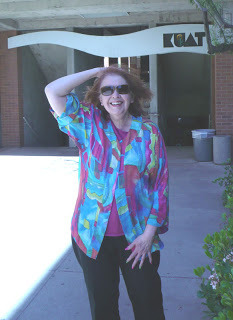 Pat returns to the spot where she was "zapped" by
Pat returns to the spot where she was "zapped" by
the Día idea at the University of Arizona, 1996.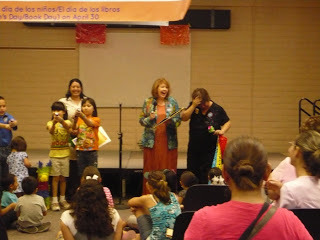 Pat and Donie GignacI spent April 30th at the Valencia Library that has a wonderful mural of my book, THE DESERT IS MY MOTHER. During the enjoyable neighborhood Día celebration complete with crafts and snacks, I had the pleasure of seeing a delightful puppet show of this book with a young library associate, Thania Mayorga-Shull, as a lovely earth mother symbolizing the desert. I smiled and smiled.
Pat and Donie GignacI spent April 30th at the Valencia Library that has a wonderful mural of my book, THE DESERT IS MY MOTHER. During the enjoyable neighborhood Día celebration complete with crafts and snacks, I had the pleasure of seeing a delightful puppet show of this book with a young library associate, Thania Mayorga-Shull, as a lovely earth mother symbolizing the desert. I smiled and smiled.
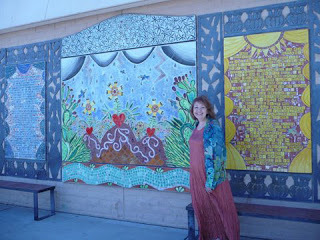 Pat by mural of "The Desert is My Mother," by Susan Gamble (1997)
Pat by mural of "The Desert is My Mother," by Susan Gamble (1997)
at the Valencia Branch of the Pima County Public Library, Tucson, AZ.
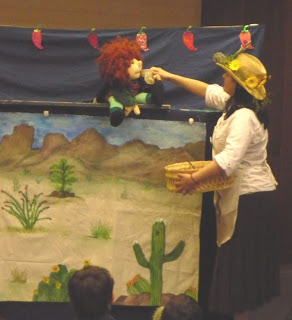 Puppet show of The Desert is My Mother at
Puppet show of The Desert is My Mother at
Valencia Library in Tucson, AZ, April 30, 2011.
 Pat returns to the spot where she was "zapped" by
Pat returns to the spot where she was "zapped" by the Día idea at the University of Arizona, 1996.
 Pat and Donie GignacI spent April 30th at the Valencia Library that has a wonderful mural of my book, THE DESERT IS MY MOTHER. During the enjoyable neighborhood Día celebration complete with crafts and snacks, I had the pleasure of seeing a delightful puppet show of this book with a young library associate, Thania Mayorga-Shull, as a lovely earth mother symbolizing the desert. I smiled and smiled.
Pat and Donie GignacI spent April 30th at the Valencia Library that has a wonderful mural of my book, THE DESERT IS MY MOTHER. During the enjoyable neighborhood Día celebration complete with crafts and snacks, I had the pleasure of seeing a delightful puppet show of this book with a young library associate, Thania Mayorga-Shull, as a lovely earth mother symbolizing the desert. I smiled and smiled.  Pat by mural of "The Desert is My Mother," by Susan Gamble (1997)
Pat by mural of "The Desert is My Mother," by Susan Gamble (1997) at the Valencia Branch of the Pima County Public Library, Tucson, AZ.
 Puppet show of The Desert is My Mother at
Puppet show of The Desert is My Mother at Valencia Library in Tucson, AZ, April 30, 2011.
Published on June 09, 2011 03:00
May 24, 2011
Creativity Interview: Steve Schecter
My first guest on this virtual salon (wouldn't it be nice to be enjoying wine or tea or coffee and "assorted sweets" as my daughters say) is Steve Schecter, an independent director, producer, writer and editor. This man of many talents lives in northern California. Thanks to friends here in Santa Fe, I met Steve a few months back and am grateful that he agreed to come to our salon. I think you'll find his work with at-risk youth and his thoughtful answers inspiring.
1) Steve, after we met, you e-mailed me and wrote that we "share the same values about the importance of creativity and children." I'm curious first about your personal creativity. Where did you grow up and do you think your childhood is connected to your creative work?
SS: I grew up all over the world, in Japan, Hong Kong, and Moscow, USSR. I always had to meet new people, and learn new languages growing up; become accustomed to new cultures. I think the flexibility and resilience that I learned as a child dealing with this adaptation to new people and places, are definitely a help with my creative life.
2) How did you become interested in creating documentaries and how do you choose your projects?
SS: I started making documentaries of my own when I was 13, after my uncle gave me a super 8 movie camera for my birthday. Before that I had taken pictures since I was about 9 with cameras my Dad gave me. I loved the magic of capturing images and sounds of the world around me, especially people; and telling stories of people's lives. I attended an ethnographic film conference at the Smithsonian when I was in high school, and that led to my first job for the Smithsonian's National Anthropological Film Center filming indigenous people around the world, beginning the summer after my freshman year at college. I started my own company to make documentaries soon after I graduated from college a few years later.
Projects often come to me, as subjects that people want a film made about. Usually, if they find me, it's because it is a subject I will be interested in. Other times there are stories that I see around me that my kids might be involved in or that are part of my community that spark my interest, because the people involved are searching for a better life or are trying to help others lift themselves up.
3) What are a few of the significant challenges of the work you do?
SS: I would say the most significant challenge is finding the funds to make the films. I do not have a formula or a constant source I go to. I look to the people who would have the most interest in seeing the film made, and try to get them involved in finding the funds in their midst.
4) One of the young people in the video links below says, "When I'm in the zone …." When are you in the zone?
SS: I am in the zone, when I am filming people and events, and my picture flows with the action. I am not thinking, but I am more like a calm lake reflecting the flow of activity and ideas. I like to shoot hand-held and move with the camera. I also get into a zone while editing, when my hands move over the keys, sewing images and sounds together in a burst of energy, creating a quilt of motion that unfolds the story as I would like.
5) I so liked the pace of your videos/films, how you steadily held my interest. Is that a skill you've always had?
SS: Thank you, Pat. I'm glad you liked the pace. That is always a tricky issue, because tastes and styles change with the times. I listen to my body and my mind as I watch what I am editing to see if there is something there that captivates me and moves me. Showing the rough cut to people is an important part of the process to see how they are responding. Whenever I watch my work with others, I always have a different response than if I watch it alone.
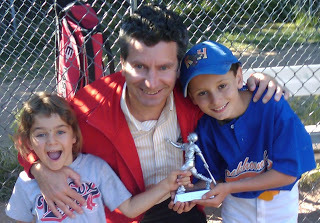
6) Now let's return to our shared interest and commitment to children and creativity. How do you nurture creativity in your own children and how could we as a country foster creativity in our young people?
SS: I think that children are a lot smarter and more creative than adults generally give them credit for. I try to listen to my kids and learn from what they have to say in their words and their art-work or writing. I think I can learn a lot about myself that way. So, as far as fostering creativity in young people, I think we just have to give them the time, the tools, and the encouragement to tell their stories in words or images. It is all there within them. Clearly it is a critically important part of their growth as human beings to tell those stories.
Watch Steve's documentary of the Niroga Institute's work with students, incarcerated youth, cancer survivors and other underserved populations. Niroga TLS students and teachers talk about how their lives have changed since discovering yoga, meditation, and Transformative Life Skills.
Mindful Kids is a documentary about the introduction of 'mindfulness' in six schools in Oakland, California, to help students overcome very difficult personal, academic, and athletic challenges. Watch the trailer.
1) Steve, after we met, you e-mailed me and wrote that we "share the same values about the importance of creativity and children." I'm curious first about your personal creativity. Where did you grow up and do you think your childhood is connected to your creative work?
SS: I grew up all over the world, in Japan, Hong Kong, and Moscow, USSR. I always had to meet new people, and learn new languages growing up; become accustomed to new cultures. I think the flexibility and resilience that I learned as a child dealing with this adaptation to new people and places, are definitely a help with my creative life.
2) How did you become interested in creating documentaries and how do you choose your projects?
SS: I started making documentaries of my own when I was 13, after my uncle gave me a super 8 movie camera for my birthday. Before that I had taken pictures since I was about 9 with cameras my Dad gave me. I loved the magic of capturing images and sounds of the world around me, especially people; and telling stories of people's lives. I attended an ethnographic film conference at the Smithsonian when I was in high school, and that led to my first job for the Smithsonian's National Anthropological Film Center filming indigenous people around the world, beginning the summer after my freshman year at college. I started my own company to make documentaries soon after I graduated from college a few years later.
Projects often come to me, as subjects that people want a film made about. Usually, if they find me, it's because it is a subject I will be interested in. Other times there are stories that I see around me that my kids might be involved in or that are part of my community that spark my interest, because the people involved are searching for a better life or are trying to help others lift themselves up.
3) What are a few of the significant challenges of the work you do?
SS: I would say the most significant challenge is finding the funds to make the films. I do not have a formula or a constant source I go to. I look to the people who would have the most interest in seeing the film made, and try to get them involved in finding the funds in their midst.
4) One of the young people in the video links below says, "When I'm in the zone …." When are you in the zone?
SS: I am in the zone, when I am filming people and events, and my picture flows with the action. I am not thinking, but I am more like a calm lake reflecting the flow of activity and ideas. I like to shoot hand-held and move with the camera. I also get into a zone while editing, when my hands move over the keys, sewing images and sounds together in a burst of energy, creating a quilt of motion that unfolds the story as I would like.
5) I so liked the pace of your videos/films, how you steadily held my interest. Is that a skill you've always had?
SS: Thank you, Pat. I'm glad you liked the pace. That is always a tricky issue, because tastes and styles change with the times. I listen to my body and my mind as I watch what I am editing to see if there is something there that captivates me and moves me. Showing the rough cut to people is an important part of the process to see how they are responding. Whenever I watch my work with others, I always have a different response than if I watch it alone.

6) Now let's return to our shared interest and commitment to children and creativity. How do you nurture creativity in your own children and how could we as a country foster creativity in our young people?
SS: I think that children are a lot smarter and more creative than adults generally give them credit for. I try to listen to my kids and learn from what they have to say in their words and their art-work or writing. I think I can learn a lot about myself that way. So, as far as fostering creativity in young people, I think we just have to give them the time, the tools, and the encouragement to tell their stories in words or images. It is all there within them. Clearly it is a critically important part of their growth as human beings to tell those stories.
Watch Steve's documentary of the Niroga Institute's work with students, incarcerated youth, cancer survivors and other underserved populations. Niroga TLS students and teachers talk about how their lives have changed since discovering yoga, meditation, and Transformative Life Skills.
Mindful Kids is a documentary about the introduction of 'mindfulness' in six schools in Oakland, California, to help students overcome very difficult personal, academic, and athletic challenges. Watch the trailer.
Published on May 24, 2011 06:49
May 9, 2011
Welcome to My New Bookjoy Creativity Salon
First, let me wish moms and the many who mother (aunts, teachers, friends) a Happy Week for all the caring and support you give. I had a fabulous mom—bright, funny, bilingually articulate, lovely to look at—I could go on and on. To a great extent I'm a writer because of her, her love of reading and books. Lots of bookjoy in our home in El Paso when I was growing up, and I hope lots of bookjoy in the home my three children grew up in, also in El Paso.
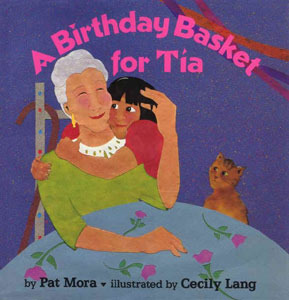 Those of you who know my work may be familiar with the aunt we all called, Lobo. All the children in the family called her that, and our friends did too. Though she never had biological children, my siblings and I and our kids were hers. The lady knew how to love and give, give, give—candies, hugs, presents, trips on the train to California, shiny shoes. And, she loved books and knowledge. My first children's book, A Birthday Basket for Tía is about her, and …. Oh yes, sh,sh, that's still a secret. Lobo died years ago, but I can still tear up talking about her. She sneaks into book after book, and …. sh,sh. Oh yes, that's still a secret. A good secret.
Those of you who know my work may be familiar with the aunt we all called, Lobo. All the children in the family called her that, and our friends did too. Though she never had biological children, my siblings and I and our kids were hers. The lady knew how to love and give, give, give—candies, hugs, presents, trips on the train to California, shiny shoes. And, she loved books and knowledge. My first children's book, A Birthday Basket for Tía is about her, and …. Oh yes, sh,sh, that's still a secret. Lobo died years ago, but I can still tear up talking about her. She sneaks into book after book, and …. sh,sh. Oh yes, that's still a secret. A good secret.
Good Books
At the beginning of the year, I received a book from my dear friend Elizabeth Mills, Prospect: The Journal of an Artist by Anne Truitt. I loved this book for so many reasons including the rich and precise vocabulary. I also appreciated how Truitt candidly spoke about her life as an artist and as a mother. I'm reading the two books that preceded Prospect, the final piece of a three volume memoir. I smile that Truitt did become a better writer as she wrote. Gives us all hope, doesn't it?
Soon, I'm diving into a new book, writing not reading. More on that (and the secret) later.
Next interview: Steve Schecter
My first guest on this virtual salon (wouldn't it be nice to be enjoying wine or tea or coffee and "assorted sweets" as my daughters say) is Steve Schecter, an independent director, producer, writer and editor. This man of many talents lives in northern California. Thanks to friends here in Santa Fe, I met Steve a few months back and am grateful that he agreed to come to our salon.
In my family memoir, House of Houses, I quote the Provencal chanson or French song, "It must have been May morning when the world was made." Isn't that how we feel on these soft May days? Wishing you good health and laughter and bookjoy this month.
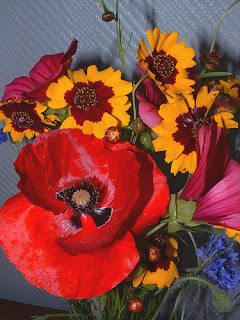 Click here for photo credit.
Click here for photo credit.
 Those of you who know my work may be familiar with the aunt we all called, Lobo. All the children in the family called her that, and our friends did too. Though she never had biological children, my siblings and I and our kids were hers. The lady knew how to love and give, give, give—candies, hugs, presents, trips on the train to California, shiny shoes. And, she loved books and knowledge. My first children's book, A Birthday Basket for Tía is about her, and …. Oh yes, sh,sh, that's still a secret. Lobo died years ago, but I can still tear up talking about her. She sneaks into book after book, and …. sh,sh. Oh yes, that's still a secret. A good secret.
Those of you who know my work may be familiar with the aunt we all called, Lobo. All the children in the family called her that, and our friends did too. Though she never had biological children, my siblings and I and our kids were hers. The lady knew how to love and give, give, give—candies, hugs, presents, trips on the train to California, shiny shoes. And, she loved books and knowledge. My first children's book, A Birthday Basket for Tía is about her, and …. Oh yes, sh,sh, that's still a secret. Lobo died years ago, but I can still tear up talking about her. She sneaks into book after book, and …. sh,sh. Oh yes, that's still a secret. A good secret.Good Books
At the beginning of the year, I received a book from my dear friend Elizabeth Mills, Prospect: The Journal of an Artist by Anne Truitt. I loved this book for so many reasons including the rich and precise vocabulary. I also appreciated how Truitt candidly spoke about her life as an artist and as a mother. I'm reading the two books that preceded Prospect, the final piece of a three volume memoir. I smile that Truitt did become a better writer as she wrote. Gives us all hope, doesn't it?
Soon, I'm diving into a new book, writing not reading. More on that (and the secret) later.
Next interview: Steve Schecter
My first guest on this virtual salon (wouldn't it be nice to be enjoying wine or tea or coffee and "assorted sweets" as my daughters say) is Steve Schecter, an independent director, producer, writer and editor. This man of many talents lives in northern California. Thanks to friends here in Santa Fe, I met Steve a few months back and am grateful that he agreed to come to our salon.
In my family memoir, House of Houses, I quote the Provencal chanson or French song, "It must have been May morning when the world was made." Isn't that how we feel on these soft May days? Wishing you good health and laughter and bookjoy this month.
 Click here for photo credit.
Click here for photo credit.
Published on May 09, 2011 08:30
May 6, 2011
Grijalva Will Receive ALA 2011 Public Service Award for Support of Libraries in Public Education
Warm congratulations from Pat to Representative Raúl Grijalva, a Library Champion.
" The Association of Library Trustees, Advocates, Friends and Foundations (ALTAFF), a division of the American Library Association (ALA), has announced it will award the 2011 Public Service Award to Rep. Raúl M. Grijalva May 9 as part of National Library Legislative Day in Washington, D.C. In 2009 and in several previous Congresses, Grijalva introduced the Strengthening Kids' Interest in Learning and Libraries (SKILLs) Act, which seeks to place at least one highly qualified school library media specialist in each public school."
Read the full press release.
" The Association of Library Trustees, Advocates, Friends and Foundations (ALTAFF), a division of the American Library Association (ALA), has announced it will award the 2011 Public Service Award to Rep. Raúl M. Grijalva May 9 as part of National Library Legislative Day in Washington, D.C. In 2009 and in several previous Congresses, Grijalva introduced the Strengthening Kids' Interest in Learning and Libraries (SKILLs) Act, which seeks to place at least one highly qualified school library media specialist in each public school."
Read the full press release.
Published on May 06, 2011 04:34
Pat Mora's Blog
- Pat Mora's profile
- 96 followers
Pat Mora isn't a Goodreads Author
(yet),
but they
do have a blog,
so here are some recent posts imported from
their feed.



